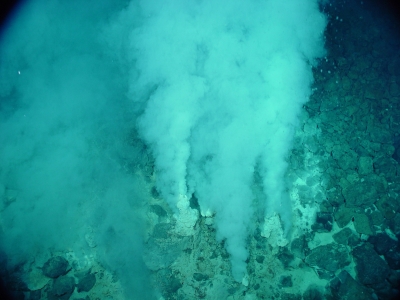
A venting black smoker emits jets of particle-laden fluids. The particles are predominantly very fine-grained sulfide minerals formed when the hot hydrothermal fluids mix with near-freezing seawater. These minerals solidify as they cool, forming chimney-like structures. “Black smokers” are chimneys formed from deposits of iron sulfide, which is black. “White smokers” are chimneys formed from deposits of barium, calcium, and silicon, which are white.
Underwater volcanoes at spreading ridges and convergent plate boundaries produce hot springs known as hydrothermal vents.
Scientists first discovered hydrothermal vents in 1977 while exploring an oceanic spreading ridge near the Galapagos Islands. To their amazement, the scientists also found that the hydrothermal vents were surrounded by large numbers of organisms that had never been seen before. These biological communities depend upon chemical processes that result from the interaction of seawater and hot magma associated with underwater volcanoes.
Hydrothermal vents are the result of seawater percolating down through fissures in the ocean crust in the vicinity of spreading centers or subduction zones (places on Earth where two tectonic plates move away or towards one another). The cold seawater is heated by hot magma and reemerges to form the vents. Seawater in hydrothermal vents may reach temperatures of over 700° Fahrenheit.
Hot seawater in hydrothermal vents does not boil because of the extreme pressure at the depths where the vents are formed.
Credit : Ocean Service
Picture Credit : Google




